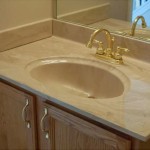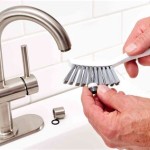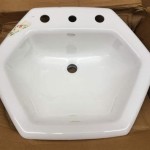Replacing a Bathroom Sink Cabinet Floor
Bathroom sink cabinets endure significant moisture exposure, making their floors particularly susceptible to water damage. Over time, this can lead to rot, weakening the cabinet's structure and potentially causing instability. Replacing the cabinet floor is a manageable DIY project that can significantly extend the cabinet's lifespan.
Before beginning the project, gather the necessary tools and materials. These include a measuring tape, safety glasses, a screwdriver, a pry bar, a jigsaw or circular saw, wood glue, wood screws, a pencil, and a replacement piece of plywood or other suitable material for the cabinet floor. Choosing a water-resistant material like marine-grade plywood is highly recommended to prevent future water damage.
The first step involves removing the existing cabinet floor. Start by emptying the cabinet completely and disconnecting the plumbing. This typically involves shutting off the water supply valves under the sink and disconnecting the P-trap. Consult a plumbing guide if unfamiliar with this process. After disconnecting the plumbing, carefully inspect the cabinet to determine how the existing floor is attached. It may be screwed, nailed, or glued in place.
Use the appropriate tools, such as a screwdriver or pry bar, to carefully remove the existing floor. Exercise caution to avoid damaging the cabinet's frame. Once the floor is removed, thoroughly clean the cabinet's interior, removing any debris or remnants of the old flooring.
With the old floor removed, accurately measure the dimensions of the cabinet's base. Transfer these measurements to the replacement piece of plywood and mark them clearly with a pencil. Using a jigsaw or circular saw, carefully cut the new floor piece according to the marked lines. Ensure a precise fit by double-checking the measurements against the cabinet opening. If necessary, make minor adjustments to the cut piece until it fits snugly within the cabinet base.
Before installing the new floor, apply a bead of wood glue along the edges of the supporting frame within the cabinet. Carefully position the cut plywood piece onto the frame, ensuring it sits flush against all sides. Secure the new floor in place using wood screws. Space the screws evenly along the edges and ensure they are driven flush with the surface of the plywood. Avoid over-tightening the screws, which could crack the wood.
After installing the new floor, allow the wood glue to dry completely according to the manufacturer's instructions. This typically takes several hours. Once the glue is dry, reconnect the plumbing fixtures, ensuring all connections are tight and secure. Turn the water supply valves back on and check for any leaks.
Choosing the right replacement material for the cabinet floor is crucial for its longevity. While standard plywood is an option, it's more susceptible to water damage. Marine-grade plywood, treated lumber, or plastic composite materials offer greater water resistance and durability, making them ideal choices for bathroom environments. Consider the specific conditions of the bathroom and choose a material that best suits the environment.
Proper maintenance after installation is essential for preserving the new cabinet floor. Regularly inspect the cabinet for any signs of water damage or leaks. Wipe up spills promptly and ensure adequate ventilation in the bathroom to minimize moisture buildup. Applying a sealant to the edges of the new floor can further protect it from water intrusion.
While replacing a bathroom sink cabinet floor is generally a straightforward process, certain situations may require professional assistance. If the cabinet frame itself is significantly damaged or rotten, or if the plumbing connections are complex, consulting a qualified plumber or carpenter is advisable. They can assess the situation and provide expert advice on the best course of action.
Several factors can contribute to the cost of replacing a bathroom sink cabinet floor. The primary factor is the material chosen for the replacement floor. Marine-grade plywood and other water-resistant materials typically cost more than standard plywood. The size of the cabinet also influences the material cost, as larger cabinets require more material. If professional assistance is required, labor costs will also contribute to the overall expense.
Prevention is always the best approach. Regularly inspecting the cabinet floor for any signs of water damage and addressing leaks promptly can significantly extend its lifespan. Ensuring adequate ventilation in the bathroom and using a bath mat to absorb excess water can further minimize the risk of moisture damage. Taking these preventative measures can save time and money in the long run.
Replacing a bathroom sink cabinet floor is a practical and cost-effective way to extend the life of the cabinet and maintain the functionality of the bathroom. By following the outlined steps and choosing the right materials, this project can be successfully completed by most DIY enthusiasts.

How To Replace A Sink Base Cabinet Floor Diy Family Handyman
:max_bytes(150000):strip_icc()/8_remove-sink-base-cabinet-56a4a26d3df78cf772835b30.jpg?strip=all)
How To Remove A Bathroom Vanity Cabinet

Floor Or Vanity First Corvus Construction

How To Replace Rotted Sink Base Cabinet Floor Bottom Easy Home Mender

How To Replace Rotted Sink Base Cabinet Floor Bottom Easy Home Mender

How To Replace Cabinet Floor Under Sink

How To Install Or Remove A Bathroom Vanity Homeserve Usa
:max_bytes(150000):strip_icc()/7_remove-vanity-top-56a4a26d3df78cf772835b2d.jpg?strip=all)
How To Remove A Bathroom Vanity Cabinet

Replacing Your Bathroom Cabinets A Guide Modernize

How To Remove Your Bathroom Sink And Vanity Dumpsters Com
Related Posts







